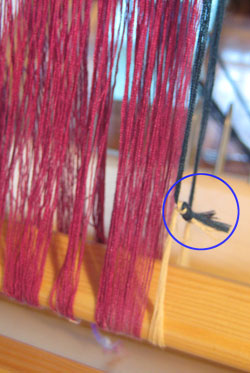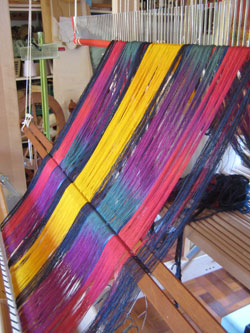
In computer terms a hack is a way of overriding a problem. It doesn’t solve the problem elegantly or ‘properly’ but it works.
I’ve recently had to discover a hack for the annoying skype code that pops up when you type a phone number in html. I’ve discovered that it is some sort of add-on to IE but when you need a phone number to display as an example in a formatting lesson you can’t guarantee that some people won’t have it installed. Luckily I discovered an ugly, yet very practical, hack to stop it happening. (I put a character after the phone number such as ” to make it seem like it isn’t a phone number then make the character a white text colour so it won’t be seen on the page).
The same applies to weaving. Here I’m attaching a warp to the back warp beam. When I wind very small warps such as this one with only 16 ends they inevitable get tangled around no matter what I do and the cross doesn’t make any sense. Instead of pulling the stick out and getting in a mess with all the other warps already organised, I just CUT the small warp, reorganise and then attach another piece of strong yarn to reconnect it. Not elegant but it works really well and is efficient.
 You can see here that this warp has alot of different smaller warps to create the whole. My hack helped make the raddling process more enjoyable….so that has to be good.
You can see here that this warp has alot of different smaller warps to create the whole. My hack helped make the raddling process more enjoyable….so that has to be good.
Once my hack, which sounds like something lacking quality or integrity, would have just been how you fix an error or unexpected problem. Like mending a broken warp end. I wonder whether the word hack is used to point out our lack of control which is seen as negative and we should somehow be doing something properly which isn’t always possible or sensible and then feel guilty and unsettled about it. I’m feeling pretty good about my hacks of the past few days though.

Leave a Reply